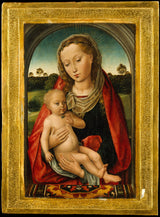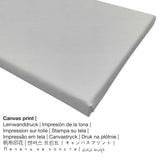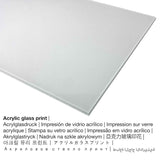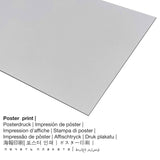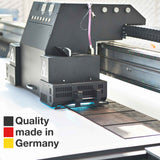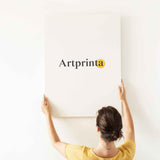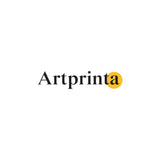Hans Memling, narị afọ nke 16 - Nwa agbọghọ na-amaghị nwoke na nwa - mbipụta nka mara mma
Ụtụ gụnyere. Mbupu gbakọrọ na ndenye ọpụpụ.
Nkọwa zuru oke sitere na ụlọ ngosi nka (© - Ụlọ ihe ngosi nka nke obodo ukwu - www.metmuseum.org)
The infant Christ, resting in his mother’s arms, delicately raises a blossom in his left hand. Mary, dressed in a gem-edged blue robe with a red mantle, gazes serenely down at her son. The pair, framed by a fictive stone archway, are positioned as if to appear directly behind a carpet-covered ledge. This aperture device was commonly used by fifteenth-century Netherlandish painters like Hans Memling to establish a sense of connection between the viewer and the painted image. The composition of the Lehman picture is an amalgam of motifs found in Virgin and Child paintings by Memling, especially a painting now in Lisbon, and is also related to an engraving of the same subject by the Master FVB. However, despite its reliance on Memling prototypes, the Lehman Virgin and Child was probably created by an early sixteenth-century artist working in the master’s style.
This painting was created by Hans Memling. The artpiece measures the size: 15 1/16 x 11 1/8 in (38,3 x 28,3 cm); painted surface 12 3/8 x 7 15/16 (31,5 x 20,2 cm). Oil on oak panel was used by the artist as the medium of the masterpiece. Nowadays, this work of art is in the the digital collection of The Metropolitan Museum of Art, which is located in New York City, New York, Njikota Obodo Amerika. The contemporary art masterpiece, which is in the public domain is being provided with courtesy of The Metropolitan Museum of Art, New York, Robert Lehman Collection, 1975. Creditline of the artwork: Robert Lehman Collection, 1975. Further, the alignment is in Eserese format ma nwee oke nke 3: 4, meaning that the length is 25% shorter than the width. Hans Memling was a male Netherlandish, whose artistic style can mainly be classified as Northern Renaissance. The European artist lived for 64 afọ, born in 1430 in Seligenstadt, Hessen state, Germany and deceased in 1494 in Bruges, West-Vlaanderen, Flanders, Belgium.
Họrọ nhọrọ ihe ebipụta nka
In the dropdown menu next to the article you can choose the size and material of your choice. We allow you to pick your favorite size and material among the following product individualization options:
- Mbipụta kanvas: A canvas print is a printed cotton canvas stretched on a wooden stretcher. The advantage of canvas prints is that they are relatively low in weight, meaning that it is easy to hang the Canvas print without the support of extra wall-mounts. Hence, canvas prints are suited for any type of wall.
- Mbipụta iko acrylic (nke nwere ezigbo mkpuchi iko n'elu): The print on acrylic glass, often named a plexiglass print, makes your chosen original into magnificient décor and forms a great alternative to dibond and canvas prints. Your own copy of the artwork will be manufactured with the help of state-of-the-art UV print machines. The effect of this are vibrant and impressive colors. The acrylic glass protects your chosen art replica against sunlight and external influences for between 40-60 years.
- Akwụkwọ mmado ebipụtara (akwa akwa akwa): Our poster is a printed cotton canvas with a slight surface finish. Please bear in mind, that depending on the absolute size of the canvas poster print we add a white margin of approximately 2-6cm round about the painting, which facilitates the framing.
- Mbipụta ọla (aluminium dibbond): Aluminium Dibond prints are prints on metal with an outstanding depth - for a modern look and non-reflective surface. The Aluminium Dibond Print is the excellent start to fine art reproductions with aluminum. For your Print On Aluminum Dibond, we print the artwork onto the surface of the aluminum composite. Colors are vivid and luminous, the fine details of the print are crisp, and the print has a a matte appearance that you can literally feel. This UV print on Aluminum Dibond is one of the most popular entry-level products and is a contemporary way to showcase art, since it puts 100% of the viewer’s attention on the image.
Ose okwu
| Ihe nkiri: | Hans memling |
| Aha ndị ọzọ: | Hemmelinck, Memling Hans, Mamline Hans, Hemelinck Hans, Hemeling, Emmelinck, Hans Memling, Hemmeling Hans, Zuan Memeglino, Hans van Brugge, Memling, Hans Hemmelinck, memling h., Hammelmik, Himmelinck, Emmelinkx, Jan van Mimnelinghe, Membling, Memmelinck Hans, John of Bruges, Memmelynghe Jan van, Jean Hemmelink, Emelinck, Memlinc Hans, Memling Khans, Heymelinck, Jean Hemelinck, hemling hans, Jean Emmelinck, Hans Memmelinck of Bruges, Hamelinck, Hemling Hans, Hans Memlinc, Memlinc Jan, Hans Hémelink, Hemelink |
| Gender: | nwoke |
| Nationality: | Dutch |
| Ọrụ: | Asụsụ Netherlands |
| Obodo onye nka: | mba netherland |
| Otu nka: | nna ukwu ochie |
| Ụdị nka: | Northern Renaissance |
| Ndụ: | 64 afọ |
| A mụrụ: | 1430 |
| Ebe amụrụ onye: | Seligenstadt, Hessen State, Germany |
| Afọ ọnwụ: | 1494 |
| Ebe ọnwụ: | Bruges, West-Vlaanderen, Flanders, Belgium |
Data nka ahaziri
| Aha nka: | "Vergin na Nwa" |
| Nhazi nka: | sere |
| Otu izugbe: | nka nka |
| Century: | 16th narị afọ |
| Usoro nka izizi: | mmanụ na oak panel |
| Nha nke ihe nka izizi: | 15 1/16 x 11 1/8 in (38,3 x 28,3 cm); painted surface 12 3/8 x 7 15/16 (31,5 x 20,2 cm) |
| Ụlọ ihe ngosi nka: | Museumlọ ihe ngosi nka nke Obodo |
| Ebe ebe ngosi nka: | New York City, New York, Njikota Obodo Amerika |
| E Nwere na: | Museumlọ ihe ngosi nka nke Obodo |
| Ikikere nke ihe osise: | ngalaba ọha |
| Site n'aka: | Ụlọ ihe ngosi nka nke Metropolitan, New York, mkpokọta Robert Lehman, 1975 |
| Ebe kredit nke ọrụ nka: | Nchịkọta Robert Lehman, 1975 |
Ngwaahịa a
| Nkewa ngwaahịa: | nka nka |
| Usoro mmeghari: | dijitalụ mmeputakwa |
| Usoro nhazi: | mbipụta dijitalụ (Mbipụta UV ozugbo) |
| Production: | emere na Germany |
| Stockdị ngwaahịa: | mmepụta ihe na-achọ |
| Ihe eji eme atụmatụ: | mgbidi gallery, nka mgbidi |
| Ndozi onyonyo a: | usoro eserese |
| Njikwa oyiyi: | (ogologo: obosara) 3: 4 |
| Nsonaazụ: | ogologo bụ 25% mkpụmkpụ karịa obosara |
| Ụdị ngwaahịa dị iche iche: | acrylic glass print (nwere ezigbo mkpuchi iko), mbipụta akwụkwọ mmado (akwụkwọ kwaaji), mbipụta kanvas, mbipụta ọla (aluminium dibond) |
| Mbipụta kanvas (akwa akwa n'elu etiti ihe ndọtị) ụdị nha dị iche iche: | 30x40cm - 12x16", 60x80cm - 24x31", 90x120cm - 35x47", 120x160cm - 47x63" |
| Mpempe iko acrylic (nwere ezigbo mkpuchi iko) nha: | 30x40cm - 12x16", 60x80cm - 24x31", 90x120cm - 35x47", 120x160cm - 47x63" |
| Nhọrọ nke mbipụta akwụkwọ mmado (akwụkwọ kwaaji): | 30x40cm - 12x16", 60x80cm - 24x31", 90x120cm - 35x47" |
| Ụdị mbipụta Dibond (ihe alumnium) dị iche iche: | 30x40cm - 12x16", 60x80cm - 24x31", 90x120cm - 35x47" |
| ụba: | na-enweghị etiti |
Ederede iwu dị mkpa: We try all that we can to describe our art products with as many details as we can and to demonstrate them visually on the product detail pages. Nevertheless, the colors of the print products and the printing can diverge to a certain extent from the representation on your screen. Depending on your screen settings and the condition of the surface, not all colors are printed as exactly as the digital version shown here. Since all the art reproductions are processed and printed by hand, there might also be minor variations in the size and exact position of the motif.
© nwebiisinka, Artprinta.com

